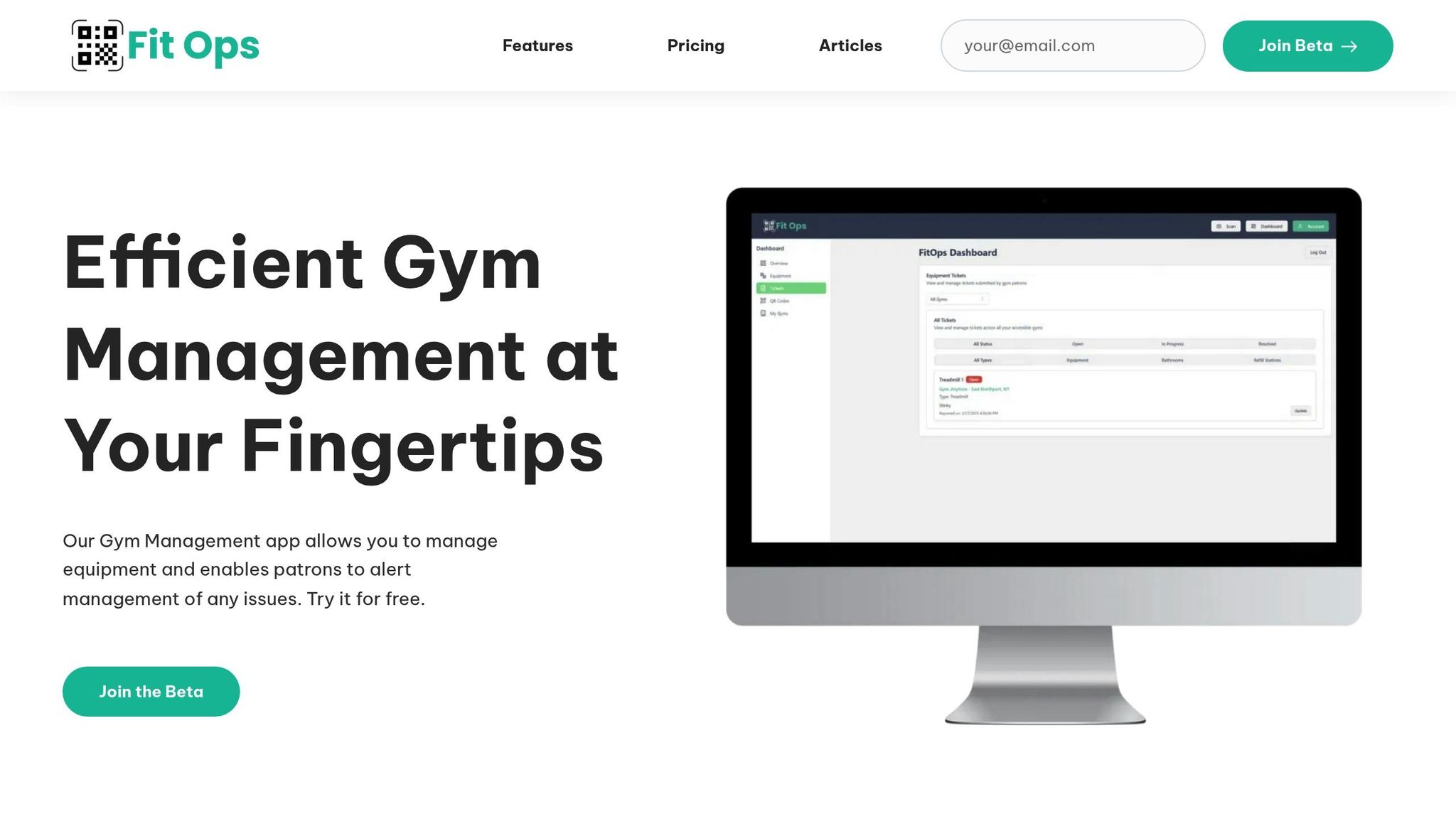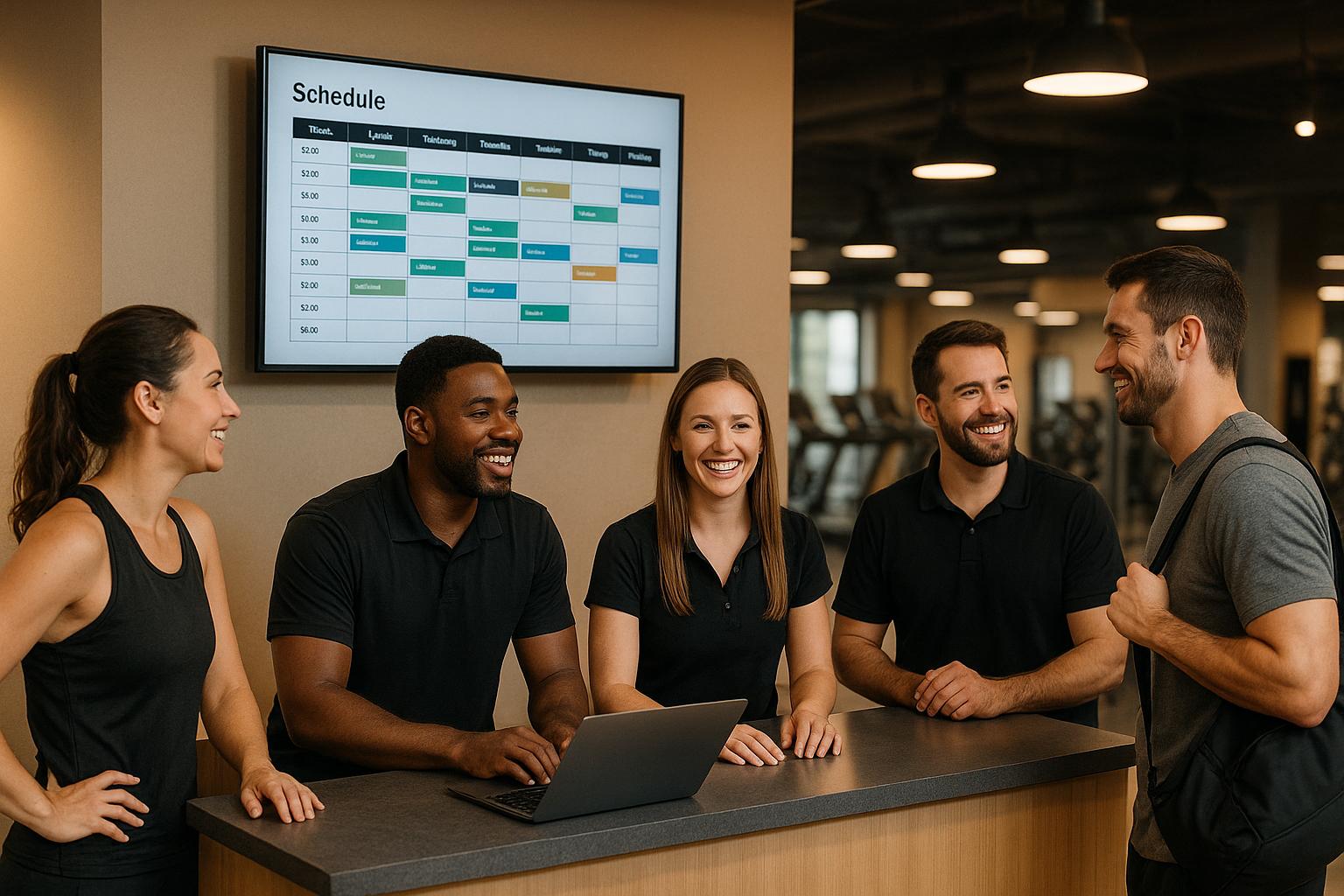Want to improve your gym's service quality? Start with feedback tools. These tools collect real-time member input, helping gyms address issues quickly, improve satisfaction, and reduce churn. While manual audits and staff observations still play a role, digital feedback systems offer faster responses, consistent data, and direct member involvement. Here's how each method stacks up:
- Feedback Tools: Offer instant issue reporting, objective data, and direct member participation.
- Manual Audits: Provide thorough reviews but are slower, subjective, and less member-focused.
- Staff Observations: Allow real-time issue spotting but can be inconsistent and rely on staff availability.
Quick Comparison:
| Method | Response Speed | Data Accuracy | Member Involvement | Impact on Satisfaction |
|---|---|---|---|---|
| Feedback Tools | Fast | High | Direct | Strong |
| Manual Audits | Slow | Moderate | Indirect | Gradual |
| Staff Observations | Variable | Low | Indirect | Inconsistent |
Best Approach? A mix of all three methods. Tools like Fit Ops Gym Management Software ($39/month per location) make digital feedback simple and effective, while audits and staff observations fill in the gaps for a balanced strategy.
1. Feedback Collection Tools
Digital tools designed for gathering feedback make it easy to capture real-time opinions from gym members. These tools provide immediate insights, helping gym operators tackle potential issues before they grow into bigger problems.
Response Speed
Imagine a member spotting broken equipment and reporting it instantly using their smartphone. With QR code–based tracking integrated into Fit Ops Gym Management Software, this scenario becomes a reality. Members can quickly flag issues, and gym staff are alerted right away. The system’s mobile-friendly design ensures it’s accessible anywhere in the facility. Beyond just reporting, the software’s analytics capabilities turn raw feedback into actionable insights, enabling managers to spot trends and address them before they escalate.
Data Objectivity
Digital tools take the guesswork out of feedback by using standardized surveys and automated data aggregation. This means gym operators get consistent and reliable data, free from bias, which helps uncover trends that might otherwise go unnoticed. These insights also open the door to more meaningful engagement with members.
Member Involvement
When members are encouraged to share their thoughts and see their feedback lead to real improvements, it fosters a sense of ownership and trust. By addressing concerns transparently, gyms can show members that their voices matter, strengthening the connection between members and the facility.
Impact on Member Satisfaction
With features like unlimited ticket logging and coordinated access for multiple users, every concern gets the attention it deserves. This thorough tracking system ensures that no issue slips through the cracks, leading to measurable improvements in service quality and, ultimately, happier members.
2. Manual Audits
Manual audits involve gym managers performing regular walkthroughs to evaluate the state of the facility, check equipment functionality, and assess service quality. This process relies on visual inspections, checklists, and personal observations to pinpoint areas that need attention.
Response Speed
Manual audits typically follow a fixed schedule, such as weekly or monthly. If an issue is identified during an audit, the timing of the next scheduled review often determines how quickly it gets addressed. This delay can leave problems unresolved for extended periods. Adding to the lag, the need for paperwork and reporting slows down the resolution process even further.
Data Objectivity
Because manual audits depend on human judgment, they naturally come with a layer of subjectivity. Different auditors might interpret the same situation in vastly different ways, influenced by their experience, mood, or personal standards. For instance, one staff member might view worn equipment as acceptable, while another might see it as an immediate safety concern. These inconsistencies make it hard to establish standard benchmarks or track trends accurately. Additionally, auditors may focus on glaring issues and overlook smaller, less obvious problems that could worsen over time. This lack of consistency makes manual audits less reliable compared to the precise, uniform feedback offered by digital tools.
Member Involvement
Manual audits often exclude gym members from the feedback loop. Members who encounter issues must either wait for the next scheduled audit or go out of their way to report the problem directly to staff. As a result, smaller annoyances frequently go unreported until they escalate into bigger frustrations. This lack of immediate action can leave members feeling unheard and disengaged. Moreover, the absence of transparency about when audits occur can further erode member trust in the system.
Impact on Member Satisfaction
The delays and inconsistencies tied to manual audits can take a toll on member satisfaction. When repairs or improvements are postponed, members may perceive the gym as undervaluing their experience. The reactive nature of this system often allows problems to grow, affecting more members and reinforcing the idea that the facility isn’t prioritizing their needs. Without access to real-time data, gym operators struggle to make quick fixes, increasing the risk of member dissatisfaction and potential churn.
3. Staff Observation
Staff observation adds another layer to service quality monitoring, complementing digital tools and manual audits. It involves frontline employees actively keeping an eye on gym conditions and service standards.
Response Speed
One of the strengths of staff observation is the ability to address issues quickly - provided employees are trained to spot and report problems promptly. However, during peak hours or when staff are juggling multiple responsibilities, response times can lag. Plus, individual perceptions can vary, so while a situation might be handled swiftly, the accuracy of what’s reported isn’t always guaranteed.
Data Objectivity
Consistency in reporting is another challenge. Employees’ varying levels of experience can lead to inconsistent observations. Personal relationships with members might also skew how staff perceive and report issues. Additionally, staff can become so accustomed to recurring problems that they stop noticing them, leading to underreporting of issues that directly affect the member experience. This "blind spot" can leave significant problems unaddressed over time.
Member Involvement
Staff observation relies heavily on members feeling comfortable enough to share their concerns with employees, creating an indirect feedback loop. But this system has its limitations. Members might hesitate to approach staff during busy periods or when employees seem preoccupied. The level of member involvement often depends on how approachable and available staff appear. High staff turnover can also disrupt the process, as members may need time to feel at ease with new employees before voicing their concerns.
Impact on Member Satisfaction
The effectiveness of staff observation in improving member satisfaction depends on how well issues are addressed and communicated. When employees act on problems quickly and visibly, members feel acknowledged and valued. On the flip side, inconsistent observation or unresolved issues can frustrate members, especially if they’ve already flagged the problem. Seeing the same issues persist can erode trust in the gym’s commitment to quality. Timely action builds confidence, but delays or neglect can lead to dissatisfaction.
These points highlight the strengths and weaknesses of staff observation compared to other monitoring methods, emphasizing the need for a balanced approach.
sbb-itb-1efabb1
Advantages and Disadvantages
Here’s a quick overview of the strengths and weaknesses of different methods for monitoring and improving gym service quality:
| Method | Response Speed | Data Objectivity | Member Involvement | Impact on Satisfaction |
|---|---|---|---|---|
| Feedback Collection Tools | Fast – Instant digital reporting and automated alerts | High – Standardized data collection with minimal bias | Direct – Members actively participate in quality monitoring | Strong – Issues are addressed quickly with visible improvements |
| Manual Audits | Slow – Scheduled reviews with delayed implementation | Moderate – Structured but influenced by auditor perspective | Indirect – Members benefit without direct input | Gradual – Long-term improvements with less immediate recognition |
| Staff Observation | Variable – Quick during low-traffic periods; slower during peak hours | Low – Subjective reporting influenced by individual experience | Indirect – Relies on members approaching staff | Inconsistent – Depends on staff training and follow-through |
Feedback Collection Tools
Digital tools excel at collecting immediate, standardized feedback, making it easier to spot trends and act quickly. They simplify the process for both gyms and members by automating alerts and reducing guesswork. For example, integrated systems can instantly notify staff about issues, ensuring faster resolutions. The structured nature of digital feedback also eliminates much of the bias seen in manual methods.
However, these tools rely heavily on member participation. Not everyone is comfortable using digital systems, and some members may prefer face-to-face communication. Maintaining their effectiveness also requires consistent efforts to educate and engage members.
Manual Audits
Manual audits provide a thorough, systematic look at gym conditions, often identifying issues that digital systems or staff might miss. These reviews are invaluable for creating detailed improvement plans and ensuring compliance with industry standards. They’re especially useful for spotting long-term trends and addressing systemic problems.
On the flip side, manual audits are time-consuming and costly. The slower pace of implementation means they’re less agile compared to digital tools, making them better suited for periodic reviews rather than day-to-day monitoring.
Staff Observation
Staff observation brings a human touch to service quality. Well-trained staff can quickly address concerns in real time and provide personalized assistance - something automated systems can’t replicate. This method also ensures continuous monitoring during operating hours.
But staff observation isn’t without its challenges. It can be inconsistent due to factors like employee turnover, varying experience levels, and individual biases. During busy times, important details may be overlooked, and relying on staff to relay member concerns can sometimes lead to gaps in communication.
A Modern Solution: Fit Ops Gym Management Software

Platforms like Fit Ops Gym Management Software demonstrate how digital systems can tackle traditional challenges. Features like QR code–based equipment tracking and instant issue reporting ensure gyms can act swiftly while maintaining data accuracy. Advanced analytics also help uncover trends that manual methods might miss, enabling a more proactive approach to service quality.
The Best Approach? A Balanced Mix
Combining digital tools with periodic manual audits and staff observations allows gyms to leverage the strengths of each method while minimizing their limitations. This blended approach ensures continuous improvement in service quality, keeping both members and staff satisfied.
Conclusion
When it comes to keeping gym service quality in check, feedback collection tools have become a cornerstone of the fitness industry. While traditional methods like manual audits and staff observations still hold their place, digital feedback systems bring the speed, accuracy, and member involvement that modern gyms need to thrive.
The comparison highlights a clear edge for feedback tools in areas where older methods struggle. These systems provide real-time alerts for emerging issues, cut down on subjective biases often present in manual evaluations, and actively engage members in the process of improving service quality. The result? Faster resolutions to problems and happier members - both essential for minimizing churn and fostering loyalty.
That said, the most effective strategy blends the strengths of all approaches. Successful gym operators pair digital feedback tools with occasional manual audits and attentive staff observations, creating a well-rounded system that ensures no detail is overlooked. This mix offers the precision and responsiveness needed to tackle issues head-on while maintaining a thorough oversight of operations.
For gyms looking to upgrade how they manage service quality, tools like Fit Ops Gym Management Software are a game-changer. At just $39 per location per month, these systems make advanced quality monitoring both accessible and practical for fitness centers of any size.
FAQs
How do feedback tools improve member satisfaction in gyms compared to traditional methods like manual audits or staff observations?
Feedback tools play a key role in boosting member satisfaction by offering a real-time and organized way to gather input. Unlike manual audits or staff observations, which can be hit-or-miss and subjective, these tools provide consistent and accurate insights into what members want and what concerns them. This enables gyms to address issues promptly, improving the overall experience.
These tools also help gyms build stronger connections with their members by using regular surveys and quick-response systems. The collected data allows gyms to adjust services to better meet specific needs, leading to happier members and lower turnover rates. By staying ahead of potential problems and focusing on continuous improvement, gyms can create a welcoming and positive space for everyone.
How can gyms encourage members to provide feedback using digital tools?
To get gym members to share feedback using digital tools, keep it easy and convenient. For example, you can use QR codes that take members straight to a feedback form or survey. This way, they can quickly share their thoughts without any hassle. Regular reminders, whether through email, app notifications, or signs around the gym, can also encourage participation.
Let members know their feedback is valued by showing them how their input has led to improvements. Sharing updates about changes made based on their suggestions fosters trust and encourages them to keep contributing. To sweeten the deal, you might offer small rewards - like discounts or free classes - as a way to thank them for their time and insights.
How can gyms combine feedback tools with audits and staff input to improve service quality?
Gyms can improve their service quality by blending digital feedback tools with manual audits and staff observations. This combination lets gyms gather real-time feedback from members while cross-referencing it with insights from staff and regular inspections. It’s a way to ensure feedback isn’t just collected but also understood in context.
An integrated solution like Fit Ops Gym Management Software makes this process easier by bringing together feedback, audit results, and staff notes in a single dashboard. With everything in one place, gyms can tackle issues promptly, boost member satisfaction, and uphold excellent service standards.


